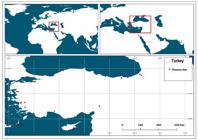ABSTRACT
Climate change has negative effects on especially plant species that have a limited habitat. In this context, the stone pine (Pinus pinea L.), which has a limited distribution, is prominent with its economic, ecological and aesthetical characteristics, and it is frequently preferred in afforestation. In this study, the habitats in Turkey that are suitable for distribution of P. pinea L. were modelled by using Maxent based on high-resolution environmental data. In total, 13 field-based occurrence points and 19 bioclimatic variables were used to model the potential distribution area under current and two prediction model (RCP4.5 and RCP8.5) for the years 2050 and 2070. According to the results, the most important bioclimatic variables effective on the potential distribution of P. pinea L. were found as the minimum temperature of coldest month (Bio6), annual precipitation (Bio12) and precipitation of wettest quarter (Bio16). Prediction models under two future climate change scenarios displayed that P. pinea L. will lose habitat and it will shift geographical distribution towards north and higher elevation sites. Considering especially the economic contributions provided by P. pinea L., these results necessitate consideration of the areas where the rate of potential distribution of the species is the highest in afforestation work aiming rural development. In addition to habitat losses, climate change affects many variables of the ecosystem.
Keywords:
Afforestation; Climate change; Geographical distribution; Bioclimatic variables; Habitat suitability; Maxent; Species distribution models

 Thumbnail
Thumbnail
 Thumbnail
Thumbnail
 Thumbnail
Thumbnail
 Thumbnail
Thumbnail



